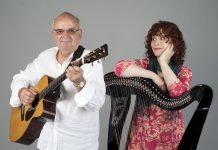

Upon meeting Bryan Yamami, the managing director for the Los Angeles based “TAIKOPROJECT,” I suddenly felt spiritually lifted by the sound of the Taiko. I thought I had come to the wrong address, because on the corner of 1st and Central in Little Tokyo, there stood a Buddhist Temple; however, the basement of that Temple is where I heard some loud thumping, and I knew it was the sound that only Taiko could make. The practicing performers for the three-day concert series were vigorous, so much so, that if this was a rehearsal, then, I just could not wait to see the live performance. There are only a few more days left until, the celebrated concert as a part of the 2014 World Taiko Gathering, set for Saturday, July, 19 and Sunday, July, 20 at the Aratani Theater, in Little Tokyo. Special guests to the “TAIKOPROJECT” include Chieko Kojima and Eiichi Saito (KODO), Kaoru Watanabe (New York), TaikOz (Sydney, Australia), Kagemusha Taiko (Exeter, U.K), Taro Kobayashi (Tokyo, Japan), Sen-Rai (Sendai, Japan) and are amongst the 500 scheduled performers would be on stage together for the first time.
The myth of how the Taiko drum came to be is as endearing as most legends of Japan and in general most Asian culture. Unlike American society, the reverence and respect paid to ancient tradition, is both elegant and honorable. As Yamami mentioned, the tradition is in place; however, augmented slightly, and applied to modern dance and music culture here in the states. According to legend, a Shinto goddess emptied a barrel of sake and then proceeded to jump on the barrels head. The goddess stomped so furiously that the percussive rhythms were loud enough for the sunlight goddess to hear. The percussive sound enticed the sunlight goddess to abandon her cave dwellings and come out, thus goes the myth of how taiko came to be.
I also took note in speaking to Yamami, that he is fourth generation Japanese. His family had experienced similar cultural setbacks as some cultures experience in the U.S. Yamami’s family had been immigrant laborers and worked in rice patty fields. In his recollection of his ancestry, I was reminded of the harsh and severe treatment slaves and other immigrants had been given, upon arriving to a foreign land. “TAIKOPROJECT” is this kind of tradition with all of its glorious history told, by the sound of the Taiko. Yamami and I talked about the series, which will intermix a three-day workshop, combining storytelling, music and choreography. The series will also include workshops and discussion sessions. “TAIKOPROJECT” has appeared in televised commercials. Their live performances have been collaborated with entertainment legends like, Stevie Wonder, Justin Bieber, Alicia Keys, John Legend, and Usher.
“Anyone can learn Taiko, and we are here to help.” Yamami said. “A lot of artist hear Taiko and want to incorporate it into their hip-hop tracks and musical arrangements. The manner in which we present Taiko makes it easy to use in nearly all musical genres.”
The upcoming concert series will bring participants from Asia, Mexico, Canada, Europe, Spain, South America, the U.S.A., Australia, Japan and Belgium. Part of the process of selection is to call around the world, in search of the top Taiko performers who participate according to their level of experience. What you may not know is that there are schools and Universities that have active Taiko clubs, a treat for any developing Taiko performer. Bryan started at age seven, reluctantly of course, but now, he is so happy that his parents forced him to learn the ancient art of beating the Taiko drum.
NEA Heritage Fellow Grand Master Seiichi Tanaka of San Francisco, aka, Tanaka Sensei, affectionately called by his students, is the highlight and part of the special guest performance. Tanaka Sensei is a legend and known as the “father of American Taiko.” During this finale, “TAIKOPROJECT” will perform a choreographed piece directed by Tanaka titled, “Expanding.”
Delighted by the interview, I left Yamami to his basement of rehearsal, swollen with the sound of the powerful Taiko: I could somehow feel the presence of the Shinto Goddess and the loud thumping of her feet echoing off the walls.
For more information on “Taiko Nation” and the 2014 World Gathering, persons interested can visit: www.TAIKOPROJECT.com and www.jaccc.org.
The Aratani/Japan America Theatre is located at 244 S. San Pedro St. in Los Angeles.












